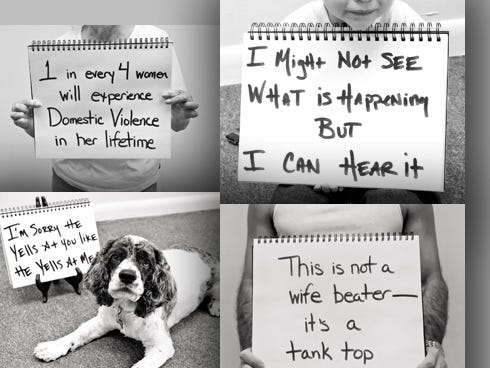
CRESTVIEW — North Okaloosa County’s number of domestic violence cases is increasing outside Crestview, but is decreasing in the Hub City, according to Crestview Police and Okaloosa County Sheriff’s Office data.
Crestview cases dipped between 2013 and 2014, and so far this year, Crestview police have logged 217 domestic violence cases, with 119 arrests, down since last year. The sheriff’s office has reported 358 cases, already topping last year’s total.
“We’ve got to find some wood to knock on,” Crestview Police Cmdr. Andrew Schneider said. “Normally when population rises, so do the number of incidents.”
OCSO domestic violence investigator Kaye Towner said she expects the county's numbers to increase even more before 2016 — “We’ve got two more months to go, and oftentimes, the holidays are a high incidence of domestic violence period," she said — but determining the origin is difficult, she said.
“It’s multi-faceted," she said. "I wish I could tell you what that one thing is because I would go fix that one thing.”
'IT'S ABOUT HAVING CONTROL'
Domestic violence includes assault, battery, aggravated assault, sexual battery with a domestic violence component, violation of injunction for protection — known as a restraining order — and stalking, Towner said.
“Out of those crimes, the most common and prevalent crimes is misdemeanor battery, which is striking or unwanted touch,” Towner said.
This year, North Okaloosa County has recorded 294 misdemeanor battery reports — up from 273 in 2014 — so more people should be aware of these crimes, Towner said.
“A lot of people think domestic violence is about the perpetrator losing control — like the perpetrator had a bad day and is pissed off and goes home, starts drinking and smacks the wife,” Towner said. “It’s not about losing control. It’s about having control.”
“Statistically, 85 percent of the time, the male is the perpetrator,” Towner said, adding that Florida Coalition Against Domestic Violence statistics show one in four women will be a domestic violence victim.
That's counting just those who report it, Towner said.
“The victims are often ashamed,” she said. “People are afraid to call law enforcement, or they just don’t know what to do.”
REASSESSING CALLS
Towner is in her second year as OCSO’s domestic violence investigator, a position funded through an annual STOP — Services Training Officers and Prosecutors — grant. Through her instruction, deputies are rethinking their approach to possible domestic violence scenes.
“When (our officers) get there, one of the parties is all cool, calm and collected. That’s when you realize that person has control of himself,” Towner said. “The victim … they might yell and scream and really act (like) a nut. It’s the first time all the rage can come out.”
A law enforcement officer could easily think the victim is hysterical, especially if the attacker has injuries, Towner said. “All (the attacker) has to do is say, ‘She just went crazy all of a sudden,’” Towner said. “He’s all calm, so the officer thinks he’s telling the truth.”
In the past, officers would then dismiss the case, Towner said. “We’d say, ‘Hey, if we have to come back here again tonight, you’re both going to jail,’” Towner said.
“It stopped people from calling us — but it didn’t stop them from beating each other up.”
ESCAPE
Domestic abuse does not always include physical violence, Towner said. “So often … you have verbal threats and talking ugly; financial control and power.”
An abuser may take away the victim’s money, or require accounting of money spent on groceries, belittling her for overspending or buying a wrong brand.
In either case, Shelter House, a nonprofit organization, advises victims on how to flee their abusers.
It starts with a phone call to their crisis hotline.
“We ask people if they’re safe and, if not, we create a safety plan for the person,” Shelter House executive director Rosalyn Iovieno said. “If we have to enter them into shelter, we’ll do that.”
Shelter House logged more than 1,800 crisis line calls during the 2014-15 fiscal year, Iovieno said, adding all calls are confidential by state law.
Planning an escape includes stashing a “bug-out kit” at a friend or relative’s house, and hiding a no-contract cell phone.
Other help, Towner said, includes seeking a free injunction against the perpetrator at the clerk of courts office. Judges are more likely to grant restraining orders if the victim cooperates with law enforcement, she said.
Whichever option you take, it's important to be careful, Townsend said, because “leaving is the most dangerous time."
—
SHELTER HOUSE
Shelter House's Crestview office — 290 Martin Luther King Jr. Ave. — provides advice and emergency shelter for domestic violence victims, and offers a 24-hour crisis line.
Call the crisis line, 863-4777, or the Crestview outreach line, 683-0845, for help.
Year CPD OCSO
2013 335 309
2014 266 350
2015* 217 358
*Through Oct. 28
Sources: Crestview Police Department and Okaloosa County Sheriff's Office
North Okaloosa County domestic violence cases
This article originally appeared on Crestview News Bulletin: Domestic violence, outside Crestview, up from last year
